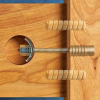I think you are broadly correct except that I would be having another piece of softwood behind the MDF/MFC to bolster the frame (the yellow pieces in my previous post). If this is the case then presumably I would have right angled corners internally ? Would I still have the issue you mention above ?
Right angle corners internally would mean that the walls of the bed would need to be extremely thick. That carries a massive weight/bulk penalty.
Also I wanted to slightly move away from the traditional design where a leg goes from each corner to the floor as I think this would be vulnerable to damage
You are now getting into the realms of a "2-layer" frame assembly - which is again heavy and potentially complex because no bracket is going to offer a sufficiently rigid solution IMHO. You really need to consider this as a 3D solution - make a 1/10th cardboard model or the like to see why you can't do things. The brackets shown cannot support te side-stresses a bed can/will place on them. Tale a look at the bracing on a decent quality dining table and you can begin to understand what is required
do you mean MDF or MFC which is finished in a beech effect?
You need to do a lot more research into the material names you are bandying around, here:
MFC - melamine-faced chipboard, a form of chipboard sheeyt with a layer of decorative (printed) paper bonded onto both side and encapsulated within a thin coating od melamine plastic
MF-MDF - melamine-faced MDF. As above but with MDF as the substrate rather than MFC
Note: As sawn (on commercial equipment) BOTH of these materials will have razor sharp edges which can easily cut through skin. The edges are rather fragile and need to be protected. This is generally achieved by either edge-banding with a self-adhesive or heat-activated adhesive tape in a matching decor to the main board (cheap but requires the edges breaking, not very durable when used on stuff like beds), or by applying a PVC or ABS edging tape some 2 to 3mm thick which they needs to be trimmed and radiused (with a router and cutter) or by applying a solid wood lipping (although that won't match the decor TBH)
Veneered MDF is where solid wood veneer is applied over an MDF substrate. The edges still need protection and either an iron-on veneer edging can be used (not particularly durable) or better still a solid wood lipping can be used and trimmed/radiused with a router.
There is no such thing as "beech effect". Something is either solid wood, veneered man-0made sheet material or melamine-faced man made material. And a printed pattern on paper can NEVER match a veneer or solid wood surface. It will always stand out like a sore thumb.
I agree - does the bolt and dowel technique I posted in my previous post address the joints sufficiently ?
Only if there is sufficient strength and thickness of tiumber in the corner components. It will be worthless for fixing the legs in place (no lateral strength) and it will probably be anappropriate for fixing an upper layer to a lower one
Thanks for this advice - by ex-stock, do you mean ex-display ?
Manufactured. Off the shelf. Not custom-made. Non-standard sizes can be manufactured by a limited number of companies, but I'd suggesting anything non-standard as the costs will simply spiral.
As to sizes, have you done any research into what standard matress sizes are? Do that and then look on bedding web sites to discover for yourself what I mean
....do you feel this is doable for a DIYer?
Yes, but you have failed to do even the most basic research into bed sizes, etc which you urgently need to address. You don't really understand the materials you are referring to at all well - another big hole in your knowledge. You are also approaching this from the point of view of designing stuff which you have no idea how to make and then expecting to find some "pro" out there to do the hard bits for you. That will cost you dear. I'd tend to start from the point of view of what I
can do
myself with the tools that I
have. Designing something you can't build yourself will probably result in complete frustration and lack of any end result. So maybe you need to take stock of your capabilities as well as doing some more fundamental design research






